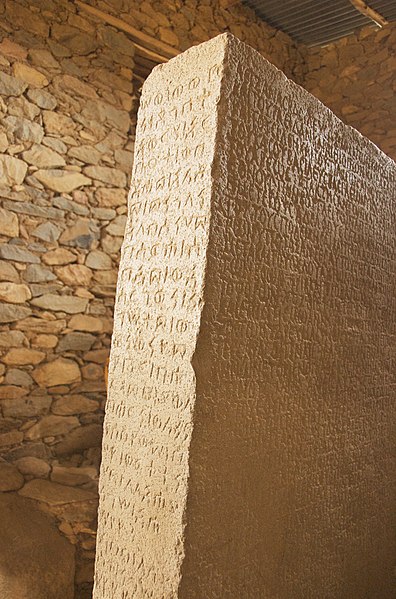The_Ezana_Stone_(2840202630).jpg

Contents
Summary
| Description The Ezana Stone (2840202630).jpg |
This tablet, situated in a field and well below today's ground surface, is believed to have been erected some time during the first half of the fourth century of the current era by King Ezana of Axum in what is now called Ethiopia. The monument is interesting for several reasons. First, it is one of the few ancient written records to come from pre-Islamic Africa, Egypt being the other major source of inscriptions. Second, the text on the Ezana Stone is written in several languages. If you Google this monument, you'll be told the monument is trilingual: Greek, which at the time was the lingua franca in many parts of the ancient world; Ge'ez, an ancient Ethiopian language that is still a liturgical language of the Ethiopian Orthodox Church and others, and Sabaean, an Old South Arabian language used in what is now Yemen and in parts of Eritrea and northern Ethiopia. However, the actual facts are much more interesting than this. Please see the comment below from fellow flickerite YomArkegzi, who explains how the text is actually bilingual, something I wasn't aware of even though I visited the site with a guide and researched this monument on the Web after my return. Third, unless I'm mistaken, the stone stands more or less where it was originally erected (or at least where it came to rest in antiquity), instead of gracing a hushed and elegant museum gallery in, say, Rome, Berlin or London, or, god forbid, a billionaire's private collection. ======================================================King Ezana ruled the Axumite Kingdom during the first half of the fourth century of the current era. Ezana is known principally for having converted to Christianity, paving the way for the eventual Christianization of Ethiopia. King Ezana also left his mark in the annals of history by invading the Kingdom of Kush in what is now southern Sudan. Sources differ on whether King Ezana conquered and put an end to the Kingdom of Kush, or merely inflicted damage that, along with other factors, led to the Kingdom of Kush's decline. =====================================================What does the tablet say, you ask? Well, I wasn't able to find a clear answer to that question. It appears King Ezana erected several "Ezana Stones" during his reign, including one in what is now southern Sudan. My default answer would have been that the monument records King Ezana's conversion to Christianity and/or his victories over the Kushites, because that seems to be the consensus on the Internets. However, I am grateful to viewer and contributor YomArkegzi, who explained the text "is actually on a campaign against the Beja in what is now NE Sudan that the inscription is about. There was a rebellion there which he suppressed; he relocated 4400 of the rebelling people and confiscated some of their cattle." |
| Date | |
| Source |
|
| Author | A. Davey from Where I Live Now: Pacific Northwest |
Licensing
-
You are free:
- to share – to copy, distribute and transmit the work
- to remix – to adapt the work
-
Under the following conditions:
- attribution – You must give appropriate credit, provide a link to the license, and indicate if changes were made. You may do so in any reasonable manner, but not in any way that suggests the licensor endorses you or your use.
|
|
This image, originally posted to Flickr , was reviewed on 5 October 2012 by the administrator or reviewer File Upload Bot (Magnus Manske) , who confirmed that it was available on Flickr under the stated license on that date. |
| Public domain Public domain false false |
|
|
This media file is in the
public domain
in the
United States
. This applies to U.S. works where the copyright has expired, often because its first
publication
occurred prior to January 1, 1929, and if not then due to lack of notice or renewal. See
this page
for further explanation.
|
|
|
|
This image might not be in the public domain outside of the United States; this especially applies in the countries and areas that do not apply the
rule of the shorter term
for US works, such as Canada, Mainland China (not Hong Kong or Macao), Germany, Mexico, and Switzerland. The creator and year of publication are essential information and must be provided. See
Wikipedia:Public domain
and
Wikipedia:Copyrights
for more details.
|
| Public domain Public domain false false |
|
|
This work is in the public domain in its country of origin and other countries and areas where the copyright term is the author's life plus 100 years or fewer . |
| This file has been identified as being free of known restrictions under copyright law, including all related and neighboring rights. | |
https://creativecommons.org/publicdomain/mark/1.0/ PDM Creative Commons Public Domain Mark 1.0 false false



